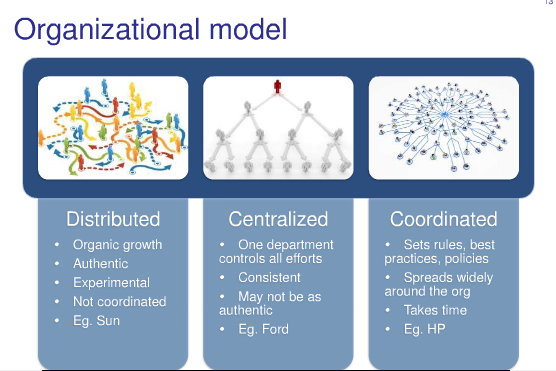Every school operates under a business organizational structure that controls the way things get done. Projects and initiatives have approval chains. But how does social media strategy fit into business organizational structures? In a blog post, Mark Greenfield asked, “Who owns social media?” Well, you can argue for the side of “no one” or “everyone” but if your school wants to be active in social media by listening, commenting, sharing and curating, you’ll have to find a way to mold a strategy that fits into your organizational structure.
Take a look at three organizational structure examples from Jeremiah Owyang in his Social Media Trends forpresentation. They are distributedcentralized, and coordinated.
Depending on your institution’s existing organizational structure, one of these strategies may work best for you. Let’s break down the pros and cons of each model.
Distributed
Think of a distributed structure as a ground-up approach. Strategies start organically within departments. There is no overarching guide or policy mandated by the institution.
Pros:
- Allows individual departments more freedom
- Can innovate and act quickly
- Very easy to get started
Cons:
- Difficult to sustain growth and evolve
- Not coordinated with entire institution
- With no guidelines or policies, messages can be very different across campus departments
- Reporting is often ignored, since there is a limited approval chain
Centralized
A centralized structure may be guided by a Marketing, Communications or Web Services department on campus. Policies and messages are all controlled by a single group.
Pros:
- Consistency in messaging
- Policy and guidelines are established and controlled
- Staff positions may be entirely dedicated to social media management
Cons:
- Allows very little flexibility within departments across the school
- The controlling department must know the needs of a variety of audiences (current students, parents, alumni, prospectives)
- Developing new strategies for specific departments can be slowed by an approval process
Coordinated
Taking the best parts of both distributed and centralized models, the coordinated approach relies heavily on overarching guidelines and best practices. Departments are well-informed of the institution’s messaging and operate effectively with their defined audiences.
Pros:
- Allows social media strategies to grow and develop under umbrella of guidelines and best practices
- Crisises are found quickly and school can react through proper channels
- Strong communities are established, both inside the institution and with external audiences
- Workshops and monthly meetings can be held to share knowledge, successes and failures
Cons:
- Collaborative work culture must develop before a coordinated approach can be successful
- Requires patience and can take years to establish
Summary
When developing a social media strategy, it is important to recognize the best fit with your current business organizational structure. In the distributed approach, a social media strategy mirrors the immediacy and ungoverned nature of social media itself. A social media strategy in a centralized structure mirrors the hierarchical and controlled business structure of the institution. The coordinated social media strategy favors culture and community within the institution.
What model works at your institution? Does your social media strategy reflect your business organizational model?

By Web Manager - Mon, Jan 31-->
-->GeneralMarketingPoliticsProject ManagementSocial Media